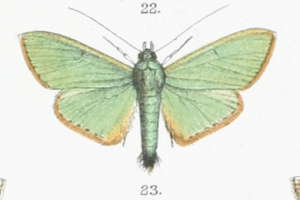Inhalt
1. Lebendfotos
1.1. Falter
1: Indonesien, Bali, Denpasar, 9. Februar 2021 (det. & fot.: Kersten Krause)
2: Bhutan, Trongsa, Trongsa, Hotelanlage, 2180 m, 22. April 2018, am Licht (det. (cf.) & fot.: Oskar Jungklaus), conf. Michel KettnerForum
3-5: ♀, Indonesien, Bali, Batubulan, 29. März 2024 (det. & fot.: Kersten Krause)
6-7: Indonesien, Bali, Batubulan, e.l. 14. Januar 2025 (cult., det. & fot.: Kersten Krause)
1.2. Raupe
1-2: Indonesien, Bali, Batubulan, 12. März 2024 (det. & fot.: Kersten Krause)
3-4: Indonesien, Bali, Batubulan, 20. und 29. Dezember 2024 (det. & fot.: Kersten Krause)
1.3. Puppe
2. Diagnose
2.1. Erstbeschreibung
1-3: Hampson (1893: 169, pl. CLXXIII fig. 23) [nach Copyright-freien Scans auf www.biodiversitylibrary.org]
3. Biologie
3.1. Habitat
3.2. Raupennahrungspflanze
1-2: Windmühlenbusch (Tabernaemontana pandacaqui): Indonesien, Bali, Batubulan, 2020 (det. & fot.: Kersten Krause)
3: Windmühlenbusch (Tabernaemontana pandacaqui): Indonesien, Bali, Sukawati, 13. November 2023 (det. & fot.: Kersten Krause)
4: Windmühlenbusch (Tabernaemontana pandacaqui): Indonesien, Bali, Sukawati, 18. Januar 2024 (det. & fot.: Kersten Krause)
4. Weitere Informationen
4.1. Andere Kombinationen
- Cenocnemis marginata Hampson,1893 [Originalkombination]
4.2. Faunistik
Nach [Global Biodiversity Information Facility] kommt die Art in Australien, Indien, Papua-Neuguinea, Sri Lanka, Philippinen, Thailand, Indonesien, Taiwan, Nepal und Singapur vor.
Locus typicus gemäß globiz.pyraloidea.org: Sri Lanka [Ceylon], Kandy.
(Autor: Michel Kettner)
4.3. Literatur
- Erstbeschreibung: Hampson, G. F. (1893): Illustrations of Typical Specimens of Lepidoptera Heterocera in the Collection of the British Museum 9: i-v, 1-182, pl. CLVII-CLXXVI. London.




![Vorkommen in Taiwan [Global Biodiversity Information Facility]](/res/img/flag/tw.gif)
![Vorkommen in Indien (Festland) [Global Biodiversity Information Facility]](/res/img/flag/in.gif)
![Vorkommen in Sri Lanka [Global Biodiversity Information Facility]](/res/img/flag/lk.gif)
![Vorkommen in Nepal [Global Biodiversity Information Facility]](/res/img/flag/np.gif)
![Vorkommen in Bhutan [Forum]](/res/img/flag/bt.gif)
![Vorkommen in Thailand [Global Biodiversity Information Facility]](/res/img/flag/th.gif)
![Vorkommen in Singapur [Global Biodiversity Information Facility]](/res/img/flag/sg.gif)
![Vorkommen auf den Philippinen [Global Biodiversity Information Facility]](/res/img/flag/ph.gif)
![Vorkommen in Indonesien [Global Biodiversity Information Facility]](/res/img/flag/id.gif)
![Vorkommen in Australien [Global Biodiversity Information Facility]](/res/img/flag/au.png)
![Vorkommen in Papua-Neuguinea [Global Biodiversity Information Facility]](/res/img/flag/pg.gif)






















